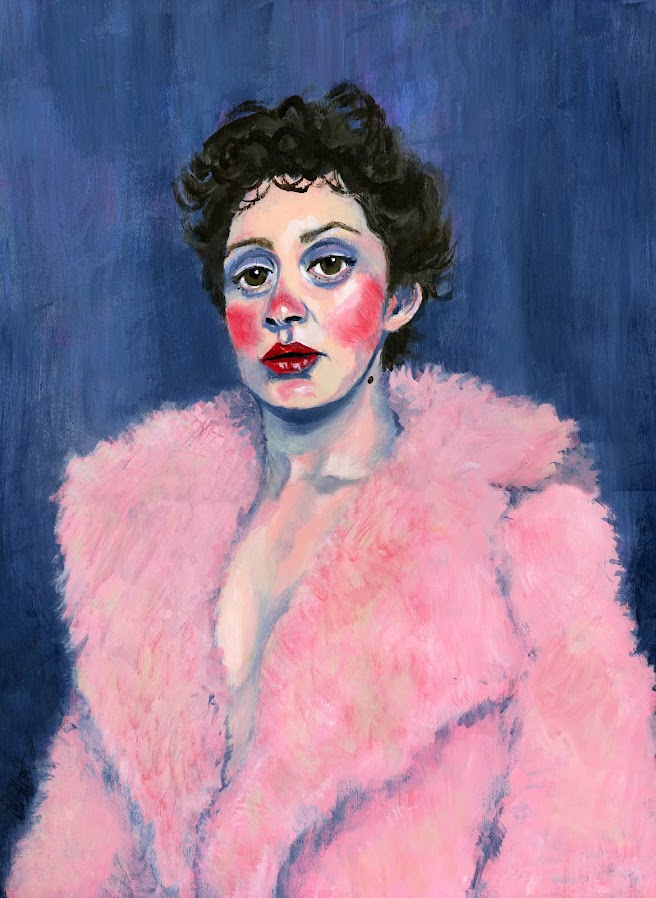11 July 2025
A different mood
21 May 2025
Homage to an amazing artist
22 April 2025
Tweaking an older work
I painted this figurative work in December of 2021, on spec for a potential client (who ended up not buying it after a lot of hemming and hawing). It was from an old photo of the client’s aunt and uncle-in-law, and she wanted it “in the style of Michael Carson”; I tried my best, but I didn’t quite get it. But I did duplicate the heavy light/shadow contrast that he goes for in his paintings, and I also captured their likenesses fairly well, given that I was working from an old, slightly blurred, colorized black-and-white photo. It was unfortunate that I got them a little high on the canvas so that his head is cut off a little, and I got their heads a bit too large for their bodies, but hey—it was my first figurative portrait in acrylic on canvas with two people in it, so...there.
In the photo, the belt on her dress is covered in white fabric, and for three years that white belt has bugged me. I initially liked it as another light point other than their faces, but after the painting sat in my studio staring at me for a while, I ultimately felt the eye was drawn too much to this insignificant detail. So, when I wanted to do some painting today but felt defeated when I looked at starting a whole new work, I decided instead to fix the belt. I made it a color to recede a bit into the dress, and gave it a gold metallic belt buckle to go with the gold in other parts of the painting, and I think it fits in a lot better. I also used the opportunity to add a few extra gathers in the dress and some strategic bits of shadow here and there.I’m still sad the client didn’t like it, but maybe someday someone else will say, Hey, that looks like an old family portrait, it would go perfectly in my library! and I will sell it. Until then, Aunt Johnny and her George will keep staring down at me.
29 March 2025
Mustering defiance
08 March 2025
Just because
28 February 2025
Petitt Special
01 February 2025
Another pose
No matter what source material I look at these days, I seem drawn back to various personalities and poses created by Jenell Del Cid, perhaps because she oh-so-accommodatingly does lots of fun photo layouts with creative wardrobe and makeup choices almost every day on her Instagram page, inspiring me to keep painting her.
This one is from a photo I saved a while back, and I was all set to use it when someone else in my LFI class did a rather perfect painting from it and stopped me in my tracks. But this week, after looking fruitlessly through a bunch of other ideas and not feeling inspired by them, I decided to come back to this one. After all, when we all do the lessons on LFI, there are about 2K of us painting from the exact same reference photo, so why should I let one painting deter me from making my own? Also, Louise Thorpe and I have somewhat different styles, so mine will be my own expression according to my peculiar choices.
That said, you could characterize this as a follow-up to the first week's lesson from Kara, given that that lesson inspired me to try to continue painting more loosely, with more painterly "chunks" left to stand on their own instead of being obsessively and seamlessly blended into everything around them. I believe this is improving my paintings, and am quite pleased with this one, although I struggled a bit with the likeness.
I got the eyes a little too large and wide-open—Jenell's are a bit more languorous in the photo—but I do love their direct gaze. I had fun with color in this one too, doing the highlights in her dark hair in an intense turquoise instead of a lighter shade of the hair color. And the background worked for me too—I started out with Cobalt Violet, but it was too dark, so I moved to a Light Violet, with Light Ultramarine glazed over it in discernible strokes and then some white at the end to give a cloudy effect.
The hardest part of this entire painting was that damn flower around her neck—I struggle with accurately duplicating things with this many disparate parts, and also with conveying the texture or material from which they are made. I know that sounds crazy, given that most people have more difficulty with portraiture than with anything; but I have had a lot of practice these past five years, and that part is beginning to be second nature.
"Jenell with Flower," pencil and acrylics on thin birch board, 12x12 inches.












